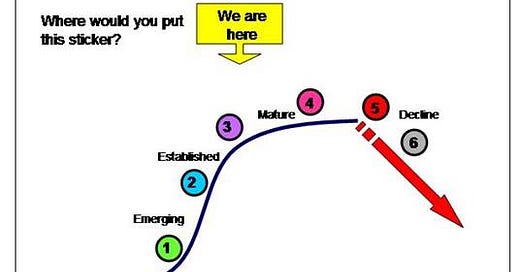Growth for Growth’s Sake: Halifax’s Unchecked Urban Expansion
The S-curve is like the life of any big idea—slow start, wild ride, then smooth sailing. Whether it’s the launch of a hot new product, the growth of a city’s population, or even your investment returns, it’s all about the S-curve. At first, things crawl, just inching along, like a startup with one loyal customer. Then comes the steep climb—everything’s exploding: users, buyers, dollars! But eventually, growth hits a ceiling, tapering off as the market saturates, populations stabilize, or your investments reach their full potential. It’s the universal story of growth: slow, fast, plateau, decline.
Everything in life follows the S.
In cities like Halifax, the conversation has shifted. It used to be about jobs: jobs, jobs, jobs—which, at least in theory, aimed to improve quality of life by providing stability, income, and a sense of purpose. But today, it’s about growth, growth, growth, with the emphasis almost entirely on urban expansion. This is particularly true for mega-municipalities like Halifax, where the vision for the future seems tethered to one principle: grow upward and outward—at all costs.
In this mindset, growth - perpetual growth - is treated as an end rather than a means. There’s no need to talk about the end of it, or the amount, or the supply. More is always better and it will never end. It's celebrated without pause, and the more square footage that gets built, the better. We’re World Class Baby. FAME!!! We’re gonna live forever!!! But just as with that bottle of Coke, we have to ask: how much is too much?
Halifax, like so many cities, is missing the crucial realization that all lines are curves. Growth without moderation, without a clear vision of its limits or an understanding of its impact on culture, beauty, and sustainability, is a recipe for diminishing returns.
The Myth of Infinite Growth
Urban growth without a guiding philosophy, without a sense of purpose or direction, often turns cities into hollow shells of what they could be. There’s little consideration for right-sizing the city to its inhabitants, its natural resources, or its cultural legacy. Instead, growth is pursued as a perpetual good, detached from the very limits that economics, the environment, and social progress demand we respect.
Economics has, at its foundation, the principle of scarcity: that resources—land, labor, capital—are finite. Yet in Halifax’s case, the growth agenda seems to ignore this truth. Developers keep pushing skyward, chasing the illusion that building more means prosperity for all. But as we know from the law of diminishing returns, there comes a point where more construction, more density, more development does not yield more value. They’re not creating something. They are selling something. Our commonwealth. And it is in dearly limited supply.
We start to see negative consequences: overburdened infrastructure, loss of nice spaces, housing crises, lower quality of life, less prosperity, and lower GDP per person.
Halifax: A City on the Curve
Halifax’s rapid urbanization has come at a cost. The city’s infrastructure is straining under the weight of new developments. Housing prices have skyrocketed, leading to a crisis of affordability. Traffic is worsening, yet public transit options remain underdeveloped. Meanwhile, neighborhoods that were once vibrant with character are being flattened to make way for condos that, ironically, make the city feel smaller—less personal, less distinct.
An urban developer class, symbolized by the rhetoric and speeches of their bought and paid-for Mayor, thought we were on the Launch or Emerging part of the curve. Probably because that’s where they were. But they were wrong. The city was at maturity.
You can be one of the just over 100 people who’ve seen this not-at-all-propagandistic bullshit interview with Mayor Savage - a man who perfectly encapsulates the three keys to getting into the Halifax Mayor Hall of Fame… Offend no one, Doubt nor Question nothing, Get behind everything.
In the rush to grow, beauty, purpose, and history have often been ignored. Public spaces—once the heart of a community—are being sacrificed for short-term gains in square footage. The human scale, so essential to making a city livable, is being replaced with glass towers and office parks that reflect not the needs of the community, but the ambitions of developers. Halifax, a city steeped in history, risks losing its sense of identity as it grows beyond its means.
The S-Curve of Urban Development
Cities, like businesses or organisms, follow an S-shaped growth curve. Early growth is rapid, as new ideas and people flood in. But without careful planning, that growth inevitably slows. In Halifax, we’re reaching that plateau, where the benefits of unchecked urban expansion are diminishing. What the city needs now is not more high-rises, but a vision for right-sizing.
Right-sizing means recognizing the limits of growth and asking deeper questions: How can we grow in a way that enhances the city’s quality of life? What does a sustainable future look like for Halifax? How can we preserve its cultural heritage while welcoming newcomers? And most importantly, when do we stop and say, “Enough”?
Scarcity and Sustainability
In any theory of economics or environmental management, scarcity is key. Cities, too, must reckon with this reality. Land, resources, and even public patience are not infinite. Halifax has reached a point where the unchecked push for growth is exhausting the very resources—both material and cultural—that make it an attractive place to live. And the size of the mistake is hurting the whole province.
To confront these issues, the city needs to rethink its priorities. It must shift from a mindset of constant expansion to one of sustainability. From Growth to Prosperity. This means planning for the kind of spaces people dream of - not what they’ll put up with when they are desperate - creating mixed-use developments that blend residential, commercial, and public spaces, and building with a focus on long-term community health rather than short-term profit or even worse, simply growth at all costs. It also means investing in transportation plans, new communities, and infrastructure that can support—not overwhelm—the existing population.
Defining “Right-Sizing” for Halifax
So, what does right-sizing look like for a city like Halifax? It’s a question of balance. Instead of growth for its own sake, the focus should shift toward improving the livability of the city. Right-sizing would mean understanding that not all growth is good growth, and that more concrete isn’t the answer to every problem. Instead, the goal should be thoughtful, strategic development that prioritizes the well-being of the people who live here.
Right-sizing means asking:
How many new units can the city’s infrastructure actually support?
How do we integrate new residents while preserving the character of long-standing neighborhoods?
How do we maintain affordable housing in the face of gentrification?
What are the cultural, environmental, and historical resources that should be protected at all costs?
A sustainable vision for Halifax would focus on quality rather than quantity. It would recognize that beauty, history, and culture are as essential to a city’s success as new buildings or bustling businesses. And it would prioritize long-term sustainability over short-term gains.
The Curve of Change
Ultimately, Halifax needs to recognize that its growth is not possible in a straight line. Like any city, it follows a curve—one that will eventually decline and falter unless we start thinking about growth differently. Instead of chasing endless expansion,
Halifax should focus on creating a city that works for the people who live here, not just for the developers who build here.
If we embrace the idea that all lines are curves, and that even the best things in life have their limits, we can build a city that thrives—balanced, sustainable, and right-sized for the future. It starts with knowing where we are on the curve.
Small Towns Big Returns - Part III
Alex Colville’s 1954 painting Horse and Train shows a lone horse charging head-on toward a speeding locomotive, symbolizing the clash between nature and unstoppable progress. We don’t need to see the next frame. We know this ends badly. When it first emerged, it resonated with a post-war world grappling with rapid technological change, industrialization…






